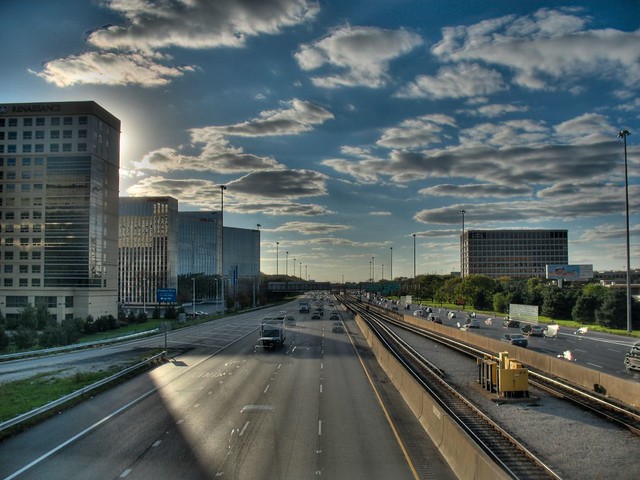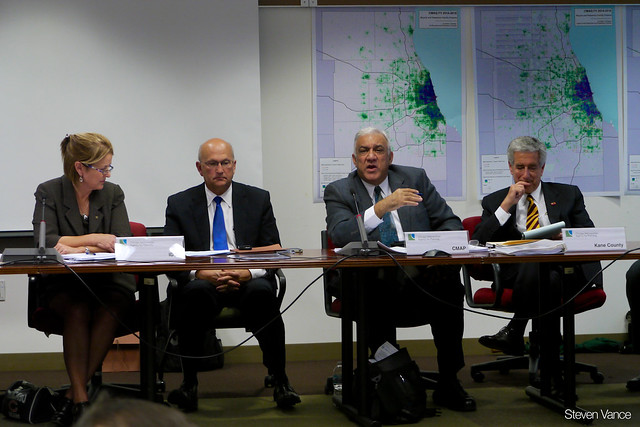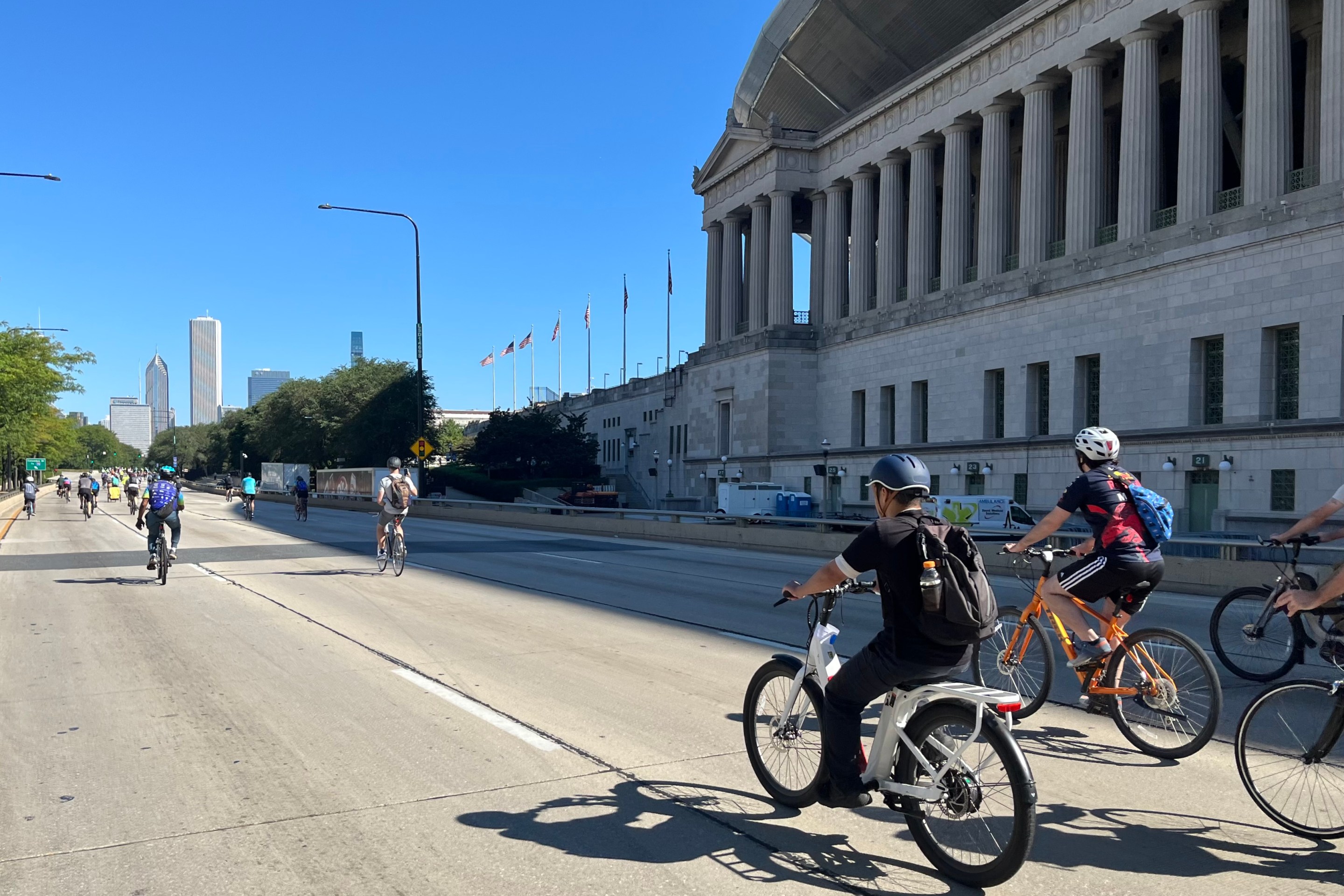
This is the second post in a two-part series on the upcoming ON TO 2050 regional plan. The first discussed public outreach goals for the new plan, and this one critiques its predecessor, GO TO 2040.
The Chicago Metropolitan Agency for Planning has launched the process to create the successor to the regional comprehensive plan, GO TO 2040. The new plan, called ON TO 2050, will illustrate with ideas, strategies, predictions, and research, what the region will be like in 2050, and how communities can get there.
GO TO 2040 is a good plan: it envisions a growing region, with an aim for sustainable, compact development in already developed areas, plus big gains in transit ridership, and bicycling and walking. What it did poorly is connect the dots between those goals and how municipalities, including Chicago, in the seven-county region can achieve them. Here are some of the praiseworthy aspects of GO TO 2040, as well as some of plan's shortcomings.
"Parking pricing" is a strategy in GO TO 2040 to maximize the use of existing resources and reduce car dependence in a neighborhood. Liz Schuh, a principal policy analyst at CMAP and ON TO 2050 co-manager, said in a phone interview, "There hasn't been much progress." That doesn't mean they haven't made inroads.
In 2013, CMAP and Metropolitan Planning Council staff thoroughly analyzed the so-called parking crunch in the area administered by the Wicker Park-Bucktown Special Service Area, a business improvement district. They found that there's plenty of unused, on-street parking, even during busy shopping or nightlife times, if only people were willing to walk an extra block or two to their destinations.
They recommended, among other ideas, testing congestion pricing in the area, with meter prices going up during high-demand periods, and falling during off-peak periods, in an effort to ensure that there's almost always a space for the person willing to pay for it, which could reducing the amount of driving people do while searching for a spot.
Another area where GO TO 2040 has fallen short is detailing how to reach certain goals, like doubling transit ridership from 2 million daily rides to 4 million daily rides by the year 2040. The plan also recommends increasing the the proportion of residents who can walk to transit from home and work. The plan doesn't say how the region can achieve these goals within the next couple of decades, beyond recommending that more transit service be provided and that new development should focus on existing developed areas, which would limit suburban sprawl. Sprawl persists.
In addition, CMAP doesn't have much power to enforce the guidelines in its existing regional plan, but that's the case with most metropolitan planning organizations across the country. Aside from the ability to decide which local transportation projects receive federal funding, CMAP doesn't have authority to use GO TO 2040 to influence development patterns. It funds and writes local plans for municipalities in the Local Technical Assistance program, but can't enforce implementation. As such, even though the plan warns that low-density sprawl requires expensive infrastructure to support it, we're still seeing plenty of new car-centric development in the region.
However, there are a few regions in the country where the local MPO has more teeth. The Portland, Oregon area, for example, has an elected regional government that also acts as the region's planning agency, with more power to influence development in local municipalities. As a result, Portland sprawls less than many metropolitan areas.
ON TO 2050 co-manager and principal planner Kristin Ihnchak said that CMAP is refining the "infill development" part of the GO TO 2040 plan. "We want to get more specific on what we mean by 'existing developed areas'," she said. Staff are looking at community and sub-community level plans across the region "to identify areas already identified by municipalities that are 'high priority areas'," Ihnchak said, which could include "commercial corridors, downtown and mixed use areas, and transit hubs and job centers." She said they might list specific geographies, but the plan will identify "types of areas in the region where we should be investing."
GO TO 2040's effectiveness has also been compromised by politics, which has resulted in CMAP endorsing projects that weren't on the plan's high priority list. The agency's board voted against endorsing the Governor Quinn's boneheaded idea to spend some $500 million on the Illiana Tollway, but CMAP's policy committee voted for it. Governor Rauner has put the breaks on the Illiana plan, but is still leaving his options open to revive it.
Another example of a project that is only included on CMAP's low priority list but is still moving forward is is Mayor Emanuel's plan for an express train between the Loop and O'Hare. While he's said that his goal is not to use any taxpayer money on creating pricey rail service geared towards business travelers, he's already spending $2 million for a feasibility study.
The lists of high-priority and low-priority projects from the GO TO 2040 Plan won't necessarily get copied over to the new plan. Schuh said they are reaching out to implementers – municipalities, counties, and transportation agencies – "to ask them about projects they want to put on here." She said they're currently looking for "regionally significant projects," whereas GO TO 2040 focused on "very large projects." "This time we're looking at our transportation networks," Schuh said, including ways to support bus rapid transit and arterial extensions.
For ON TO 2050, CMAP is implementing a new policy on a trial basis. To be considered for inclusion in the new plan, most types of projects need to have a projected cost of at least $250 million. However, the new policy allows projects that "change capacity on the National Highway System (NHS) or that are new expressways or principal arterials" or "change capacity on transit services with some separate rights-of-way or shared right-of- way where transit has priority over other traffic" to be included if they're estimated to cost at least $100 million.
But that $100 million threshold still sets too high a bar for many bus-priority projects. For example, while the Ashland BRT project, estimated to cost $160 million, would meet that threshold, the Loop Link project, which cost $41 million, wouldn't have been eligible.
Meanwhile, the policy sets too low a bar for projects that would add highway capacity for single-occupant vehicles. As I've written before, these kind of projects conflict with anti-sprawl goals of GO TO 2040.
Perhaps because it has been difficult to implement GO TO 2040, CMAP has proposed administering a new revenue source called FUND 2040. It could be used to fund transit stations, multi-use trails, and stormwater management infrastructure, among other things. This would give the agency more power to get these "regionally-significant projects" implemented.
![]()
Did you appreciate this post? Streetsblog Chicago is currently funded until April 2016. Consider making a donation through our PublicGood site to help ensure we can continue to publish next year.






